Introduction
Super PACs and other outside groups — most made possible by the U.S. Supreme Court’s 2010 Citizens United decision — spent more than $1 billion on advertising in federal races through Election Day, with 10 organizations accounting for more than half the total.
Conservative groups accounted for roughly 70 percent of spending, including more than $440 million on the presidential race alone, a sum that helped keep Republican Mitt Romney competitive in his bid to unseat President Barack Obama.
The spending wasn’t enough to put the former Massachusetts governor in the White House — nor was it enough for Republicans to wrest control of the Senate away from the Democrats, despite the proliferation of Senate and House candidate-specific super PACs.
The Center for Public Integrity analyzed spending data from the Center for Responsive Politics, gathered from the Federal Election Commission.
David Keating, the president of the Center for Competitive Politics, which favors campaign finance deregulation, says this gusher of spending by outside groups was a boon for democracy.
“There were a lot of competitive races, and super PACs were one of the key reasons why,” said Keating, who added that the nascent groups “helped keep Romney competitive,” especially between April, when GOP rival Rick Santorum dropped out of the presidential primary race, and the Republican National Convention in August.
The well-funded re-election efforts of Obama — who did not face a serious primary challenge — were fueled to a large degree by small-amount donors, while Romney relied on wealthier patrons, many of whom also shelled out to pro-Romney super PACs.
The challenger needed the help.
Obama’s campaign raised more than $632 million in the 2012 election through mid-October, 62 percent more than Romney’s $389 million. Even when including money raised by the Democratic and Republican National Committees, Obama still led by $166 million: $924 million to $758 million.
The Big 3
Three GOP-aligned groups accounted for nearly a third of all spending by outside groups, according to the Center’s analysis.
Restore Our Future, the super PAC founded by Romney allies to aid his presidential quest, spent more than $140 million — more than any other outside group. While the $40 million Restore Our Future spent during the GOP primary played a pivotal role in helping Romney win the party’s nomination, the $100 million it sank into the presidential election wasn’t enough to oust Obama.
American Crossroads and Crossroads GPS, the super PAC and nonprofit co-founded by GOP strategist Karl Rove, ranked second and third, respectively, among outside spenders.
American Crossroads spent nearly $105 million on the 2012 election, including more than $91 million on the presidential race and more than $12 million on high-profile Senate races. Crossroads GPS reported spending about $71 million, 55 percent on Senate races, 14 percent on House races and 31 percent on the presidential contest.
The groups’ top congressional target was the U.S. Senate race in Virginia, where they reported spending a combined $11 million aiding Republican George Allen, who was narrowly defeated by Democrat Tim Kaine. Allen was also assisted by a super PAC called Independence Virginia PAC, which spent nearly $5 million on attacks against Kaine.
The groups also spent more than $7.4 million in Wisconsin, where Democratic Rep. Tammy Baldwin bested former Gov. Tommy Thompson; more than $7 million in Nevada, where incumbent Republican Sen. Dean Heller prevailed over Democratic challenger, Rep. Shelley Berkley; and about $6.4 million in Ohio, where incumbent Democratic Sen. Sherrod Brown successfully fended off a challenge by Republican Josh Mandel.
Everybody’s ‘going to want’ a super PAC
According to the Center’s analysis of spending by super PACs, nonprofits, traditional political action committees and other groups that reported advertisements to the FEC, the fourth-most prolific outside spender was Priorities USA Action, the primary super PAC supporting Obama’s re-election efforts. It spent more than $67 million — all of it on attacks on Romney.
One of the group’s most notable ads featured a worker who described how building the stage on which officials announced a plant’s closure, after it was bought by Romney’s Bain Capital, was like building his “own coffin.”
According to Bob Biersack, a senior fellow at the Center for Responsive Politics, the phenomenon of candidate-specific super PACs won’t be going away anytime soon.
“Everybody’s going to want a Restore Our Future or a Priorities USA Action,” Biersack said. “Everybody’s going to want that.”
Tuesday marked the first presidential election under the new campaign finance regime installed following the 2010 Citizens United U.S. Supreme Court decision and a lower-court ruling.
The high court’s 5-4 decision paved the way for super PACs and nonprofits, allowing them to accept unlimited contributions from individuals, corporations and unions, which could be spent on advertising backing or opposing candidates.
Some of Democrats who prevailed Tuesday despite the onslaught of spending against them noted this during their victory speeches.
In Ohio, Brown applauded his supporters for fighting back “against secretive, out-of-state forces that wanted to impose their will on us,” while in Virginia, Kaine contended that his victory proved that “it’s the number of people who stand behind you, not the number of zeroes behind the check.”
Andrea Fuller and Alexandra Duszak contributed to this report.
Read more in Money and Democracy
Money and Democracy
Californian spends $44 million, loses ballot initiative fight
Taxes, charter schools, unions on state ballots
Money and Democracy
Outside spending makes big difference in state-level races
Citizens United decision impact goes beyond D.C.

Join the conversation
Show Comments